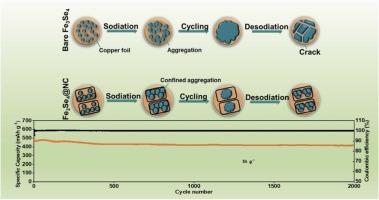Optimized architectural engineering and interface modulation in metallic-phase selenide for exceptional sodium-storage performance
IF 16.8
1区 材料科学
Q1 CHEMISTRY, PHYSICAL
引用次数: 0
Abstract
Transition metal selenides (TMSs) exhibit promise as anode materials for sodium-ion batteries (SIBs) due to their high specific capacity and diverse electronic properties. However, practical implementation faces challenges such as structural deterioration, solid-electrolyte interphase (SEI) instability, and diminished coulombic efficiency, especially at the nanoscale. Here, we introduce a novel approach that combines surface engineering of Fe3Se4 with an interface engineering strategy (Fe3Se4@NC) to effectively address these issues. By incorporating engineered void spaces and an electrolyte-blocking layer within micrometer-sized secondary clusters, Fe3Se4 nanoparticles gain the ability to expand and contract freely during cycling, thereby preserving interparticle connections and enhancing the structural integrity. The synergy of surface engineering with a nitrogen-doped carbon layer and interface engineering through electrolyte modulation leads to an outstanding 95.1 % initial Coulombic efficiency in the Fe3Se4@NC electrode. Even after 2000 cycles at 5 A g−1, the electrode retains over 89.2 % of its initial capacity with an average specific capacity of 450 mAh g−1. In situ transmission electron microscopy (TEM) and in situ X-ray diffraction (XRD) analysis shed light on the structural evolution and sodiation dynamics during charge/discharge process. Experimental investigations and DFT calculations provide a comprehensive understanding of the SEI composition and the structural stability of the composite.

优化金属相硒化物的结构工程和界面调制,实现卓越的钠存储性能
过渡金属硒化物(TMSs)因其高比容量和多样化的电子特性,有望成为钠离子电池(SIBs)的负极材料。然而,在实际应用中面临着结构退化、固电解质相间(SEI)不稳定性和库仑效率降低等挑战,尤其是在纳米尺度上。在此,我们介绍一种结合了 Fe3Se4 表面工程和界面工程策略(Fe3Se4@NC)的新方法,以有效解决这些问题。通过将工程空隙和电解质阻挡层纳入微米级次级簇群,Fe3Se4 纳米粒子在循环过程中获得了自由伸缩的能力,从而保持了粒子间的连接并增强了结构的完整性。通过掺氮碳层的表面工程和电解质调制的界面工程的协同作用,Fe3Se4@NC 电极的初始库仑效率达到了 95.1%。即使在 5 A g-1 的条件下循环使用 2000 次后,该电极仍能保持超过 89.2% 的初始容量,平均比容量为 450 mAh g-1。原位透射电子显微镜(TEM)和原位 X 射线衍射(XRD)分析揭示了充放电过程中的结构演变和钠化动力学。实验研究和 DFT 计算提供了对 SEI 成分和复合材料结构稳定性的全面了解。
本文章由计算机程序翻译,如有差异,请以英文原文为准。
求助全文
约1分钟内获得全文
求助全文
来源期刊

Nano Energy
CHEMISTRY, PHYSICAL-NANOSCIENCE & NANOTECHNOLOGY
CiteScore
30.30
自引率
7.40%
发文量
1207
审稿时长
23 days
期刊介绍:
Nano Energy is a multidisciplinary, rapid-publication forum of original peer-reviewed contributions on the science and engineering of nanomaterials and nanodevices used in all forms of energy harvesting, conversion, storage, utilization and policy. Through its mixture of articles, reviews, communications, research news, and information on key developments, Nano Energy provides a comprehensive coverage of this exciting and dynamic field which joins nanoscience and nanotechnology with energy science. The journal is relevant to all those who are interested in nanomaterials solutions to the energy problem.
Nano Energy publishes original experimental and theoretical research on all aspects of energy-related research which utilizes nanomaterials and nanotechnology. Manuscripts of four types are considered: review articles which inform readers of the latest research and advances in energy science; rapid communications which feature exciting research breakthroughs in the field; full-length articles which report comprehensive research developments; and news and opinions which comment on topical issues or express views on the developments in related fields.
 求助内容:
求助内容: 应助结果提醒方式:
应助结果提醒方式:


